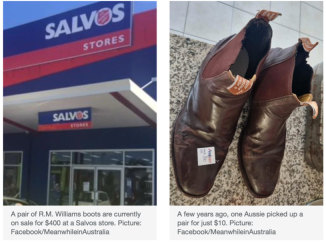
As Fashion Week Australia 2025 wraps up and the dust from Fashion Revolution Week 2025 settles, one uncomfortable truth remains: Australia is the world’s largest consumer of clothing per capita.
Every year, Australians buy an average of 56 new pieces of clothing, more than any other country in the world per capita.
Despite rising awareness of fashion’s environmental practices, the fashion industry continues to produce cheap clothing, while landfills fill up with the waste from fast-changing trends.
This April, as Fashion Revolution Week pushed to “Think Globally, Act Locally”, questions were once again raised about whether Australia is truly shifting its approach to fashion waste.
A week of awareness, but are we listening?
Fashion Revolution, a global movement born in 2013 in the wake of the Rana Plaza collapse, has become a platform that holds the fashion industry accountable.
In Australia, the annual campaign “Fashion Revolution Week” occurred from April 22 to 27, 2025, hosting clothing swaps, repair workshops, and panels pushing for transparency, ethical production, and more conscious consumption.

Yet the numbers remain discouraging. The fast fashion market is worth $2.3 billion, Australians are dumping 200,000 tonnes of mostly synthetic clothing yearly, and fast fashion giants Shein and Temu attract 2.5 million shoppers a month, driving overproduction and waste.
Meanwhile, just three weeks after Fashion Revolution Week called for change, Australian Fashion Week 2025 was held from May 12 to 16 at Sydney’s Carriageworks.
A single runway show creates massive waste, from temporary structures to lighting and sound systems, bringing the question of whether we are truly listening.

For Aya Richardson, Country Coordinator for Fashion Revolution Australia, two worlds exist: a sustainable one and a fashion one.
“There are a lot of events and spaces that are specifically for sustainability, like the sustainable fashion industry, and those conversations I think sometimes can feel like they’re in a little bit of a bubble and separate from mainstream fashion,” she said. “I think closing that gap is needed. Closing the gap between the sustainable fashion industry and the mainstream fashion industry.”
“We’re Caught in a Loop”
For Richardson, the fashion waste tragedy is deeply embedded in the system.
“I think it’s just a result of so many things…production, fast trend cycles, and marketing. They’re manipulating us to feel like we need to constantly buy,” she said.
Richardson also notes the rise of “ultra-fast fashion” as a major contributor.
“ You can see something now, like today, maybe a celebrity is wearing some new style, and then tomorrow a designer from a fast fashion brand can create that design and then have it mass-produced pretty quickly and get it in stores,” she said.
That speed is enabled by global supply chains reliant on low-wage labour, and consumers being unaware of what they are wearing.
“People don’t realize their wardrobe is full of plastic, there’s a huge awareness gap,” said Richardson.
This gap persists despite growing concern, 63% of Australians say they are worried about the environmental impact of textile waste, but only 27% know that more than half of the clothing sold locally is made from plastic-based materials.
Elliot Duncan, a thrift-shop worker at Fabrique Vintage in Sydney, supports this view, noting that fast fashion brands like H&M use poor-quality materials, forcing people to buy replacements more often.
Solutions: Thrifting Isn’t Enough
Remedies for the fashion waste loop are gaining traction, with second-hand shopping booming, as more than three in four Australians are now buying second-hand.
However, while thrifting sustains the circulation of clothes, stores are overwhelmed with donations, and only 10 to 30% of donated clothes are purchased from thrift stores by consumers.
This change brings concerns about a new pattern: “fast-thrifting”, where the focus is still on constant buying rather than on reducing consumption altogether.

A visit to Sydney thrift shops revealed the reality of the situation. Alexa Dyne, a 21-year-old student browsing denim jackets, admitted she thrifts regularly. “It’s cheap and better than buying new,” she said. “But yeah… I do end up with stuff I don’t wear that much.”
Can AI Disrupt the Cycle?
As second-hand shopping proves to be less effective than hoped, researchers are now looking toward innovative solutions. Professor Shahriar Akter, a digital sustainability expert at the University of Wollongong, believes artificial intelligence (AI) could help reshape the industry.
In a recent study, Akter proposes a framework called AI-powered climate service innovation capability (AIPCSI), using AI to support sustainability by predicting demand, creating bio-based materials, and reducing overproduction.
For Richardson, this implementation is not a guarantee. “AI can be used for good and bad, I imagine that people will try to do both,” she said. “It might help reduce waste, but it could also make production even faster. They’ll be able to use AI to create patterns for clothes so quickly.”
Good Intentions, Harsh Realities: Where change begins.
Many consumers are stuck between knowing what is right and choosing what is easy. “I go thrifting and follow sustainable fashion pages,” said Dyne. “But when I see cheap clothes online, it’s hard to say no. I thrift often, but it doesn’t feel like enough.”
This gap between intention and action sits at the heart of the fashion waste crisis. Without real alternatives and a cultural shift in how we think about buying clothes, Australians will stay caught in the same loop.
So, where does change begin? Thrifting and AI can help, but they are not enough on their own. The problem runs deeper. It is about mindset and values.
“Shift your mindset,” said Richardson. “Think about what you actually like, not just what’s trending. Build a real relationship with your clothes.”
Overall, solving Australia’s fashion waste crisis will take more than good intentions, it requires mindset shifts and systemic changes.
Subscribe to The Guardian’s “Down to Earth” Newsletter
Wordcount: 1009





Be the first to comment